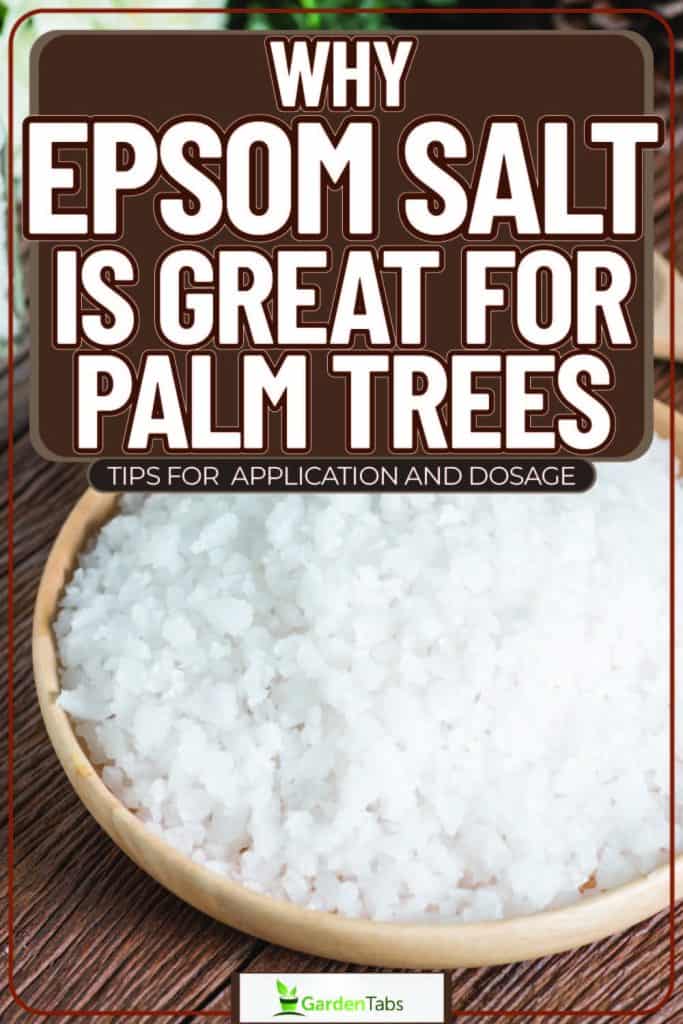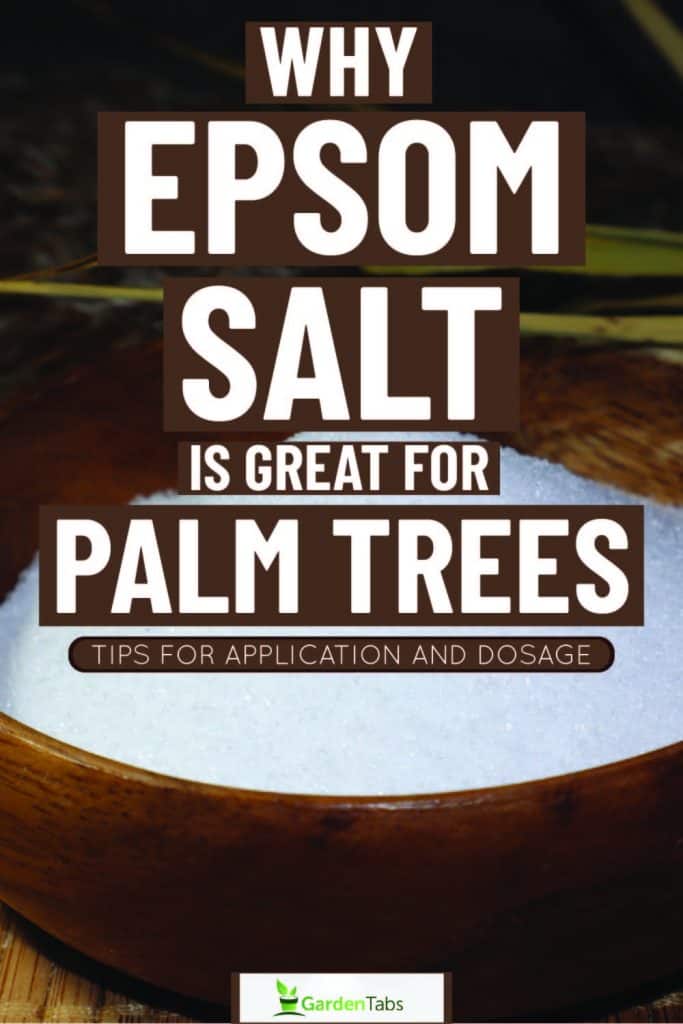Are you a palm tree enthusiast looking to take your tree care to the next level?
Look no further than Epsom salt! This natural mineral, also known as magnesium sulfate, can work wonders for palm trees.
Epsom salt can help your trees grow stronger, healthier, and more vibrant. But how does it work, and how can you use it effectively?
In this article, we'll dive deep into the world of Epsom salt and palm trees.
We'll explore the science behind how Epsom salt can improve the health of your trees and provide you with practical tips on how to apply it.

Benefits Of Epsom Salt For Palm Trees
If you're a gardener or have palm trees in your yard, you may have heard about the benefits of Epsom salt. We'll cover the amazing benefits of Epsom salt for palm trees below.

Improves Nutrient Absorption
If your palm trees are not getting enough magnesium, they can suffer from a deficiency that leads to the yellowing of the leaves.
Epsom salt contains magnesium, which can help to treat and prevent this condition.
But the benefits of Epsom salt go beyond treating magnesium deficiency.
The magnesium in Epsom salt can aid the tree in absorbing other essential nutrients, including nitrogen and phosphorus.
This means that your palm trees will be healthier and more resistant to disease and pests.
Boosts Photosynthesis
Epsom salt offers another advantage to palm trees by enhancing their photosynthesis process.
Photosynthesis is the mechanism through which plants transform sunlight into energy.
Chlorophyll, which gives plants their color, relies heavily on magnesium as a fundamental component.
By supplying adequate magnesium to your palm trees, you can ensure that they have sufficient chlorophyll to facilitate effective photosynthesis.
This, in turn, enables your palm trees to generate more energy and grow at a faster pace.
Improves Soil
Epsom salt improves soil quality by boosting its fertility and structure.
With better soil, your palm trees can develop stronger roots that can reach deeper into the ground to access more nutrients and water.
How To Apply Epsom Salt To Palm Trees
1. Choose The Right Type Of Epsom Salt
It's important to choose the right type of Epsom salt.
Make sure to select a high-quality salt that is free of any additives or scents. You can find Epsom salt at your local gardening store or online.
Click here to see this Epsom salt on Amazon.
2. Prepare The Solution
To prepare the Epsom salt solution, add one tablespoon of salt to one gallon of water. Stir the mixture until the salt is completely dissolved.
3. Apply The Solution
Apply the solution to the palm tree by pouring it around the base of the tree.
Make sure to apply the solution evenly around the tree to ensure that all roots receive the benefits of the Epsom salt.
You can use a garden sprayer to apply the solution.
Water the tree thoroughly after the application to help the salt dissolve into the soil.
Click here to see this garden sprayer on Amazon.
Dosage & Frequency Of Epsom Salt Application
When it comes to applying Epsom salt to palm trees, it is important to use the correct dosage and follow a schedule for application.
Determining The Correct Dosage
The dosage of Epsom salt for your palm tree will depend on the size of the tree and the severity of the nutrient deficiency.
A general rule of thumb is to use two tablespoons of Epsom salt per nine square feet of soil around the base of the tree.
However, it's important to consult with a professional arborist to determine the exact dosage for your specific tree.
Applying too much Epsom salt can lead to salt buildup in the soil, which can damage the roots of the tree.
You should follow the recommended dosage and not exceed it.
If you notice any negative effects after application, such as leaf burn or wilting, reduce the dosage for future applications.
Frequency Of Application
The frequency of Epsom salt application will depend on the severity of the nutrient deficiency and the growth rate of the tree.
It's recommended to apply Epsom salt to palm trees every two to three months during the growing season (spring and summer).
However, if your tree is showing signs of nutrient deficiency, such as yellowing leaves or stunted growth, you may need to apply Epsom salt more frequently.
It is crucial to keep in mind that the use of Epsom salt does not replace the need for appropriate fertilization and soil maintenance.
Regular fertilization, soil testing, and proper irrigation are essential for the health of your palm tree.
Epsom salt should be used as a supplement to these practices, not a replacement.

Potential Risks To Palm Trees
While Epsom salt can be beneficial for palm trees, it's important to avoid overusing it.
Over-application of Epsom salt can cause an accumulation of magnesium in the soil, which can be detrimental to the health of the palm tree.
It's recommended to use Epsom salt sparingly and only when necessary.
Although Epsom salt can be beneficial for palm trees, there are some potential risks to be aware of.
If you apply too much Epsom salt, it can cause the palm tree to become dehydrated and wilted.
Additionally, applying Epsom salt to a palm tree that doesn't need it can lead to nutrient imbalances and other problems.
Other Factors To Consider
When using Epsom salt on your palm tree, it's important to consider other factors that can affect its health.
For example, palm trees need other nutrients like nitrogen, phosphorus, and potassium that they get from commercial fertilizers.
Additionally, palm trees can be sensitive to certain types of soil, so it's important to ensure that your soil is well-draining and has the right pH level.
Finally, it's important to follow proper safety precautions when handling Epsom salt.
Always wear gloves and safety goggles when mixing and applying Epsom salt solutions to avoid skin and eye irritation.
Click here to see this gloves on Amazon.
Wrapping Up
Epsom salt is a natural, cost-effective solution that can help your palm trees thrive.
It can help improve soil quality, prevent magnesium deficiency, and promote healthy growth.
You can also use Epsom salt to make a foliar spray for your palm trees. Simply mix Epsom salt with water and spray it on the leaves.
When applying Epsom salt, it's important to follow the recommended dosage and frequency.
Too much Epsom salt can harm your palm trees, so make sure to measure carefully and not overdo it.
By following the tips provided in this article, you can ensure that your palm trees stay healthy and beautiful for years to come.
Before you go, take a look at some additional essential information we have about palm trees below.








